MGT226 Project 3: Critical Evaluation of Health and Safety Training
VerifiedAdded on 2023/01/11
|13
|3795
|30
Report
AI Summary
This report provides a critical evaluation of the H&S Representative course, an occupational health and safety training program conducted by WorkSafe in New Zealand. The report assesses the program's effectiveness within Air New Zealand, examining its purpose, objectives, and evaluation processes. It discusses the role of Health and Safety Representatives (HSRs) in ensuring workplace safety, their training, and responsibilities under the Health and Safety at Workplace Act 2015. The evaluation covers the evaluation process, including training standards, HSR duties, and the PCBU's role. The report highlights issues within Air New Zealand's implementation of the program and concludes with recommendations for improvement, aiming to enhance employee health and safety practices. The report also includes an executive summary, discussion of the evaluation process, conclusions, results, and recommendations, with references. The report is a part of the MGT226 course, focusing on occupational health and safety training strategies and evaluation.
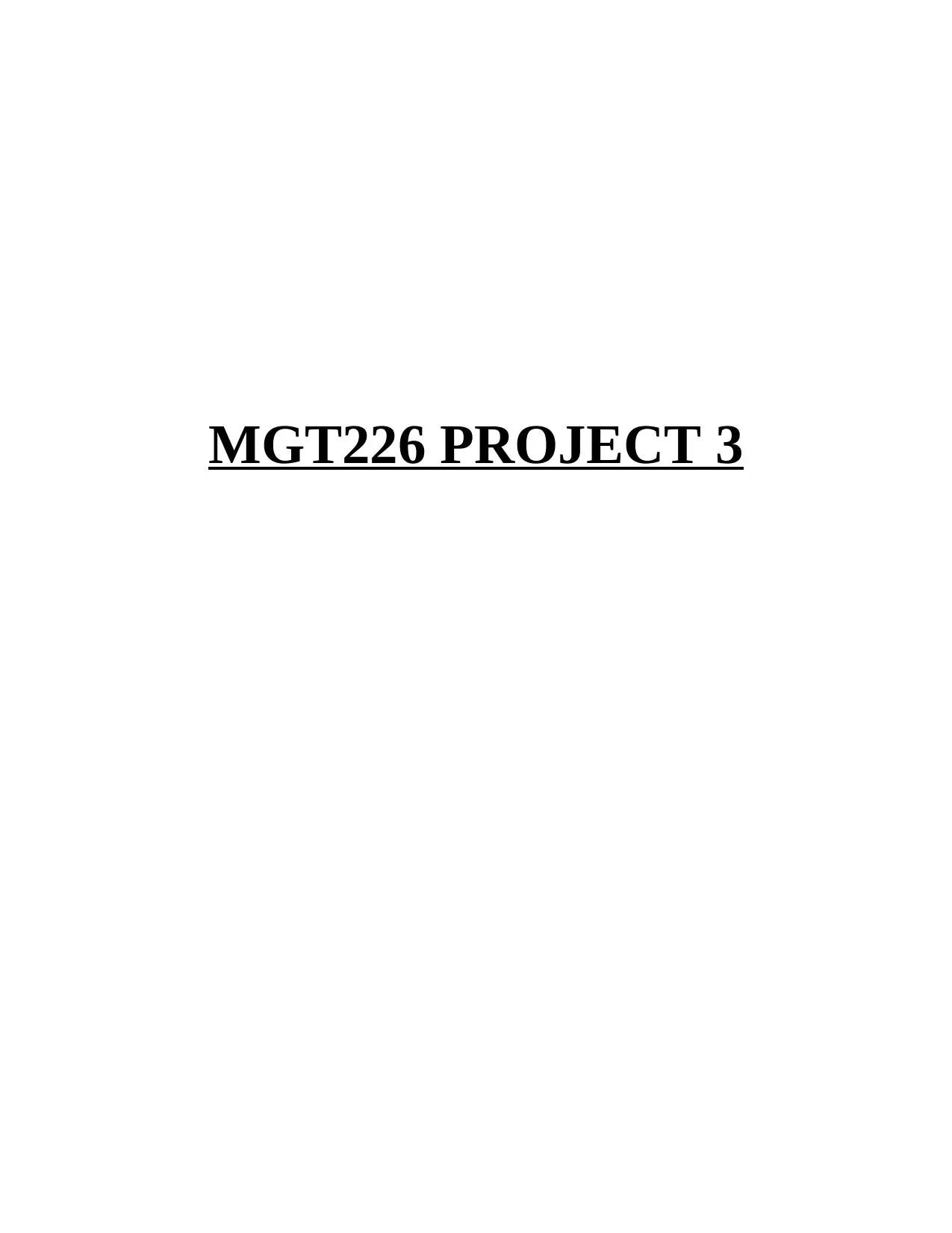
MGT226 PROJECT 3
Paraphrase This Document
Need a fresh take? Get an instant paraphrase of this document with our AI Paraphraser
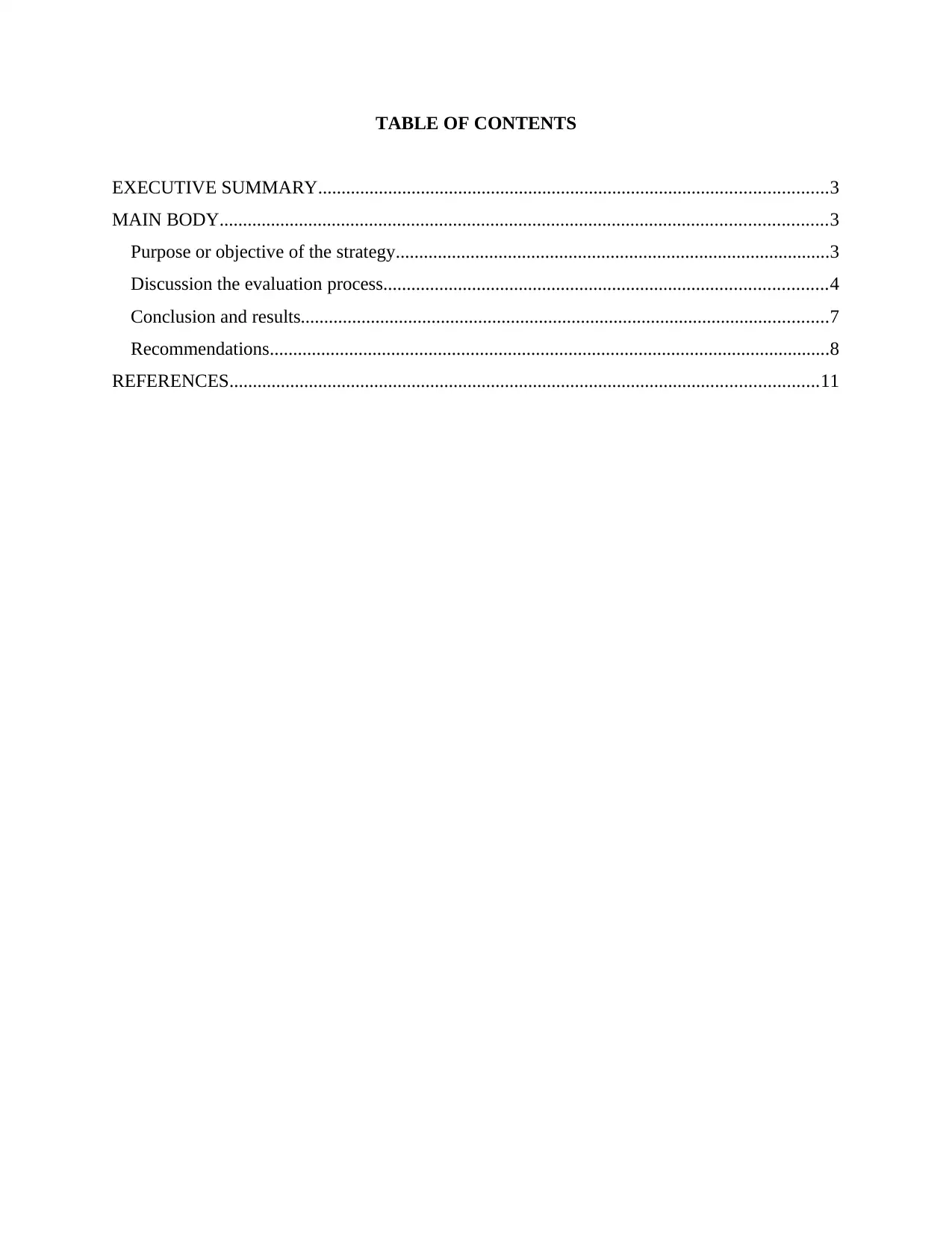
TABLE OF CONTENTS
EXECUTIVE SUMMARY.............................................................................................................3
MAIN BODY..................................................................................................................................3
Purpose or objective of the strategy.............................................................................................3
Discussion the evaluation process...............................................................................................4
Conclusion and results.................................................................................................................7
Recommendations........................................................................................................................8
REFERENCES..............................................................................................................................11
EXECUTIVE SUMMARY.............................................................................................................3
MAIN BODY..................................................................................................................................3
Purpose or objective of the strategy.............................................................................................3
Discussion the evaluation process...............................................................................................4
Conclusion and results.................................................................................................................7
Recommendations........................................................................................................................8
REFERENCES..............................................................................................................................11
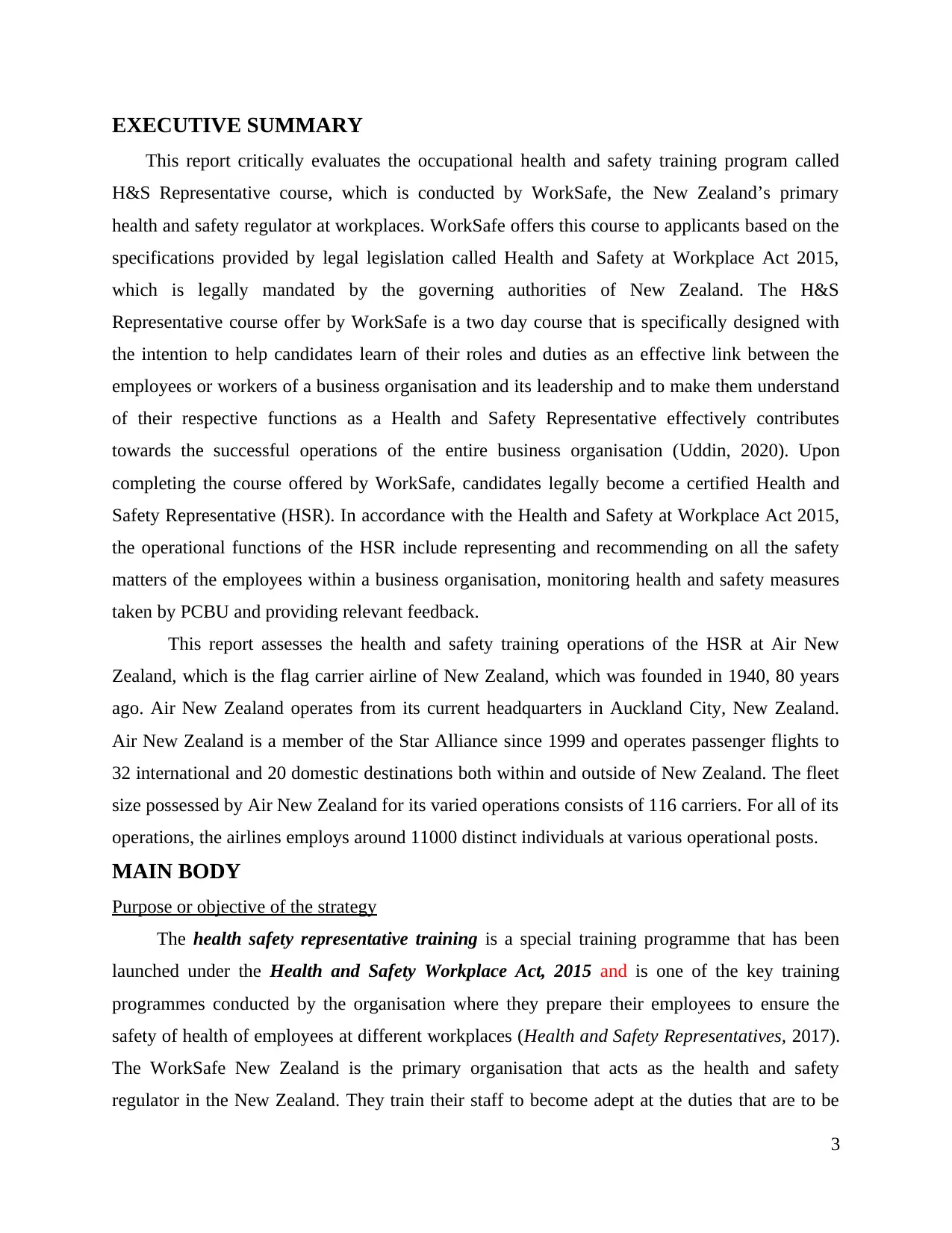
EXECUTIVE SUMMARY
This report critically evaluates the occupational health and safety training program called
H&S Representative course, which is conducted by WorkSafe, the New Zealand’s primary
health and safety regulator at workplaces. WorkSafe offers this course to applicants based on the
specifications provided by legal legislation called Health and Safety at Workplace Act 2015,
which is legally mandated by the governing authorities of New Zealand. The H&S
Representative course offer by WorkSafe is a two day course that is specifically designed with
the intention to help candidates learn of their roles and duties as an effective link between the
employees or workers of a business organisation and its leadership and to make them understand
of their respective functions as a Health and Safety Representative effectively contributes
towards the successful operations of the entire business organisation (Uddin, 2020). Upon
completing the course offered by WorkSafe, candidates legally become a certified Health and
Safety Representative (HSR). In accordance with the Health and Safety at Workplace Act 2015,
the operational functions of the HSR include representing and recommending on all the safety
matters of the employees within a business organisation, monitoring health and safety measures
taken by PCBU and providing relevant feedback.
This report assesses the health and safety training operations of the HSR at Air New
Zealand, which is the flag carrier airline of New Zealand, which was founded in 1940, 80 years
ago. Air New Zealand operates from its current headquarters in Auckland City, New Zealand.
Air New Zealand is a member of the Star Alliance since 1999 and operates passenger flights to
32 international and 20 domestic destinations both within and outside of New Zealand. The fleet
size possessed by Air New Zealand for its varied operations consists of 116 carriers. For all of its
operations, the airlines employs around 11000 distinct individuals at various operational posts.
MAIN BODY
Purpose or objective of the strategy
The health safety representative training is a special training programme that has been
launched under the Health and Safety Workplace Act, 2015 and is one of the key training
programmes conducted by the organisation where they prepare their employees to ensure the
safety of health of employees at different workplaces (Health and Safety Representatives, 2017).
The WorkSafe New Zealand is the primary organisation that acts as the health and safety
regulator in the New Zealand. They train their staff to become adept at the duties that are to be
3
This report critically evaluates the occupational health and safety training program called
H&S Representative course, which is conducted by WorkSafe, the New Zealand’s primary
health and safety regulator at workplaces. WorkSafe offers this course to applicants based on the
specifications provided by legal legislation called Health and Safety at Workplace Act 2015,
which is legally mandated by the governing authorities of New Zealand. The H&S
Representative course offer by WorkSafe is a two day course that is specifically designed with
the intention to help candidates learn of their roles and duties as an effective link between the
employees or workers of a business organisation and its leadership and to make them understand
of their respective functions as a Health and Safety Representative effectively contributes
towards the successful operations of the entire business organisation (Uddin, 2020). Upon
completing the course offered by WorkSafe, candidates legally become a certified Health and
Safety Representative (HSR). In accordance with the Health and Safety at Workplace Act 2015,
the operational functions of the HSR include representing and recommending on all the safety
matters of the employees within a business organisation, monitoring health and safety measures
taken by PCBU and providing relevant feedback.
This report assesses the health and safety training operations of the HSR at Air New
Zealand, which is the flag carrier airline of New Zealand, which was founded in 1940, 80 years
ago. Air New Zealand operates from its current headquarters in Auckland City, New Zealand.
Air New Zealand is a member of the Star Alliance since 1999 and operates passenger flights to
32 international and 20 domestic destinations both within and outside of New Zealand. The fleet
size possessed by Air New Zealand for its varied operations consists of 116 carriers. For all of its
operations, the airlines employs around 11000 distinct individuals at various operational posts.
MAIN BODY
Purpose or objective of the strategy
The health safety representative training is a special training programme that has been
launched under the Health and Safety Workplace Act, 2015 and is one of the key training
programmes conducted by the organisation where they prepare their employees to ensure the
safety of health of employees at different workplaces (Health and Safety Representatives, 2017).
The WorkSafe New Zealand is the primary organisation that acts as the health and safety
regulator in the New Zealand. They train their staff to become adept at the duties that are to be
3
⊘ This is a preview!⊘
Do you want full access?
Subscribe today to unlock all pages.

Trusted by 1+ million students worldwide
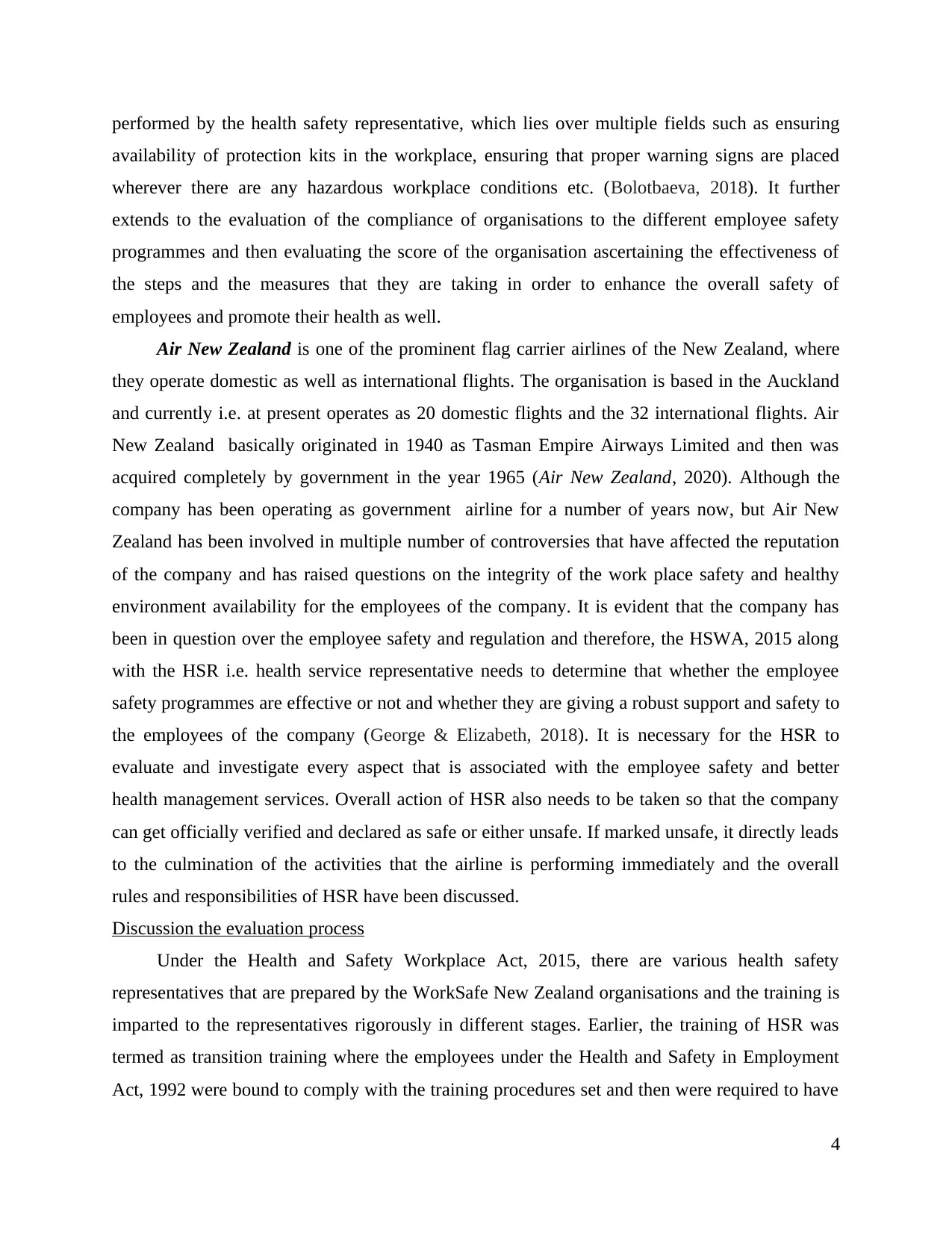
performed by the health safety representative, which lies over multiple fields such as ensuring
availability of protection kits in the workplace, ensuring that proper warning signs are placed
wherever there are any hazardous workplace conditions etc. (Bolotbaeva, 2018). It further
extends to the evaluation of the compliance of organisations to the different employee safety
programmes and then evaluating the score of the organisation ascertaining the effectiveness of
the steps and the measures that they are taking in order to enhance the overall safety of
employees and promote their health as well.
Air New Zealand is one of the prominent flag carrier airlines of the New Zealand, where
they operate domestic as well as international flights. The organisation is based in the Auckland
and currently i.e. at present operates as 20 domestic flights and the 32 international flights. Air
New Zealand basically originated in 1940 as Tasman Empire Airways Limited and then was
acquired completely by government in the year 1965 (Air New Zealand, 2020). Although the
company has been operating as government airline for a number of years now, but Air New
Zealand has been involved in multiple number of controversies that have affected the reputation
of the company and has raised questions on the integrity of the work place safety and healthy
environment availability for the employees of the company. It is evident that the company has
been in question over the employee safety and regulation and therefore, the HSWA, 2015 along
with the HSR i.e. health service representative needs to determine that whether the employee
safety programmes are effective or not and whether they are giving a robust support and safety to
the employees of the company (George & Elizabeth, 2018). It is necessary for the HSR to
evaluate and investigate every aspect that is associated with the employee safety and better
health management services. Overall action of HSR also needs to be taken so that the company
can get officially verified and declared as safe or either unsafe. If marked unsafe, it directly leads
to the culmination of the activities that the airline is performing immediately and the overall
rules and responsibilities of HSR have been discussed.
Discussion the evaluation process
Under the Health and Safety Workplace Act, 2015, there are various health safety
representatives that are prepared by the WorkSafe New Zealand organisations and the training is
imparted to the representatives rigorously in different stages. Earlier, the training of HSR was
termed as transition training where the employees under the Health and Safety in Employment
Act, 1992 were bound to comply with the training procedures set and then were required to have
4
availability of protection kits in the workplace, ensuring that proper warning signs are placed
wherever there are any hazardous workplace conditions etc. (Bolotbaeva, 2018). It further
extends to the evaluation of the compliance of organisations to the different employee safety
programmes and then evaluating the score of the organisation ascertaining the effectiveness of
the steps and the measures that they are taking in order to enhance the overall safety of
employees and promote their health as well.
Air New Zealand is one of the prominent flag carrier airlines of the New Zealand, where
they operate domestic as well as international flights. The organisation is based in the Auckland
and currently i.e. at present operates as 20 domestic flights and the 32 international flights. Air
New Zealand basically originated in 1940 as Tasman Empire Airways Limited and then was
acquired completely by government in the year 1965 (Air New Zealand, 2020). Although the
company has been operating as government airline for a number of years now, but Air New
Zealand has been involved in multiple number of controversies that have affected the reputation
of the company and has raised questions on the integrity of the work place safety and healthy
environment availability for the employees of the company. It is evident that the company has
been in question over the employee safety and regulation and therefore, the HSWA, 2015 along
with the HSR i.e. health service representative needs to determine that whether the employee
safety programmes are effective or not and whether they are giving a robust support and safety to
the employees of the company (George & Elizabeth, 2018). It is necessary for the HSR to
evaluate and investigate every aspect that is associated with the employee safety and better
health management services. Overall action of HSR also needs to be taken so that the company
can get officially verified and declared as safe or either unsafe. If marked unsafe, it directly leads
to the culmination of the activities that the airline is performing immediately and the overall
rules and responsibilities of HSR have been discussed.
Discussion the evaluation process
Under the Health and Safety Workplace Act, 2015, there are various health safety
representatives that are prepared by the WorkSafe New Zealand organisations and the training is
imparted to the representatives rigorously in different stages. Earlier, the training of HSR was
termed as transition training where the employees under the Health and Safety in Employment
Act, 1992 were bound to comply with the training procedures set and then were required to have
4
Paraphrase This Document
Need a fresh take? Get an instant paraphrase of this document with our AI Paraphraser
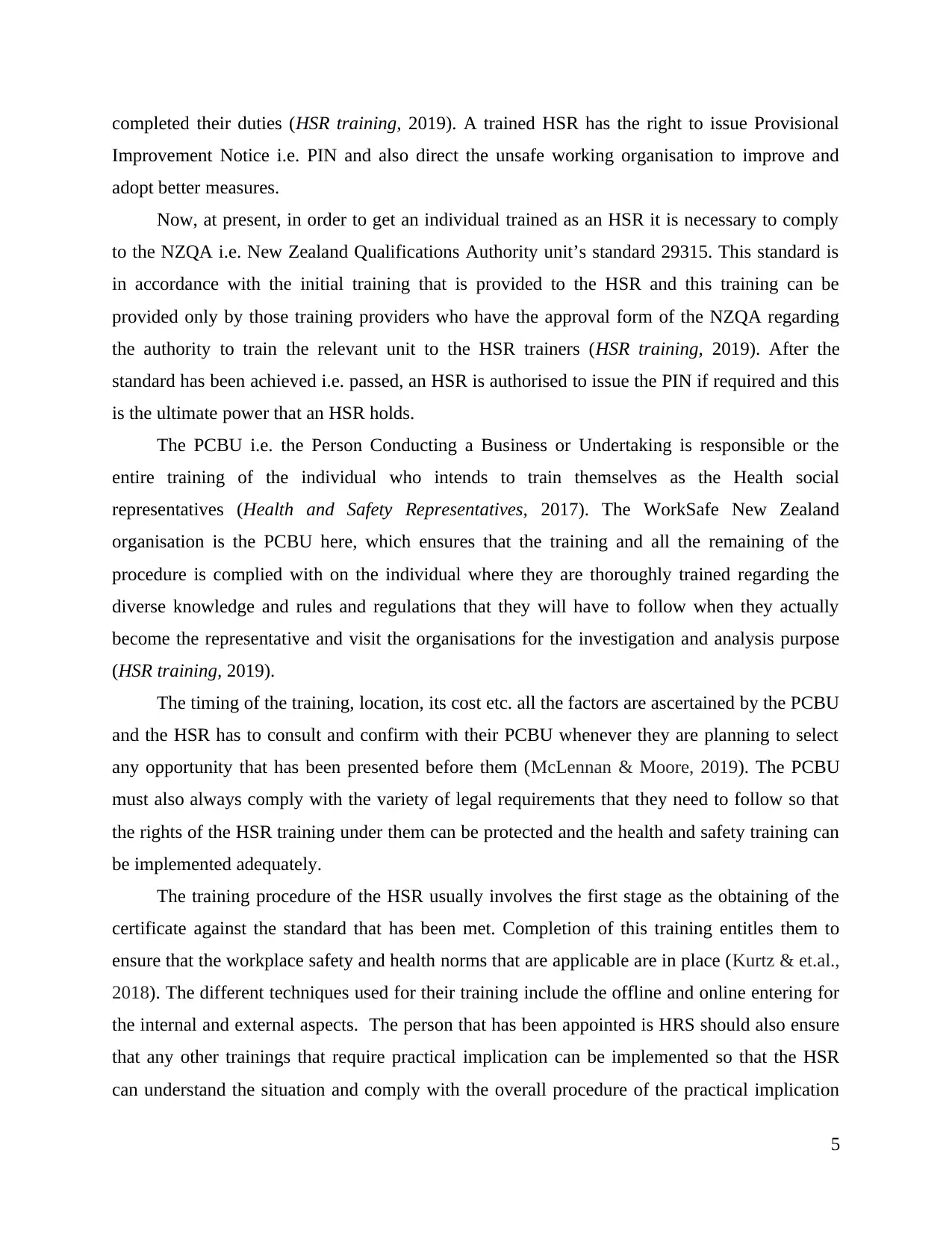
completed their duties (HSR training, 2019). A trained HSR has the right to issue Provisional
Improvement Notice i.e. PIN and also direct the unsafe working organisation to improve and
adopt better measures.
Now, at present, in order to get an individual trained as an HSR it is necessary to comply
to the NZQA i.e. New Zealand Qualifications Authority unit’s standard 29315. This standard is
in accordance with the initial training that is provided to the HSR and this training can be
provided only by those training providers who have the approval form of the NZQA regarding
the authority to train the relevant unit to the HSR trainers (HSR training, 2019). After the
standard has been achieved i.e. passed, an HSR is authorised to issue the PIN if required and this
is the ultimate power that an HSR holds.
The PCBU i.e. the Person Conducting a Business or Undertaking is responsible or the
entire training of the individual who intends to train themselves as the Health social
representatives (Health and Safety Representatives, 2017). The WorkSafe New Zealand
organisation is the PCBU here, which ensures that the training and all the remaining of the
procedure is complied with on the individual where they are thoroughly trained regarding the
diverse knowledge and rules and regulations that they will have to follow when they actually
become the representative and visit the organisations for the investigation and analysis purpose
(HSR training, 2019).
The timing of the training, location, its cost etc. all the factors are ascertained by the PCBU
and the HSR has to consult and confirm with their PCBU whenever they are planning to select
any opportunity that has been presented before them (McLennan & Moore, 2019). The PCBU
must also always comply with the variety of legal requirements that they need to follow so that
the rights of the HSR training under them can be protected and the health and safety training can
be implemented adequately.
The training procedure of the HSR usually involves the first stage as the obtaining of the
certificate against the standard that has been met. Completion of this training entitles them to
ensure that the workplace safety and health norms that are applicable are in place (Kurtz & et.al.,
2018). The different techniques used for their training include the offline and online entering for
the internal and external aspects. The person that has been appointed is HRS should also ensure
that any other trainings that require practical implication can be implemented so that the HSR
can understand the situation and comply with the overall procedure of the practical implication
5
Improvement Notice i.e. PIN and also direct the unsafe working organisation to improve and
adopt better measures.
Now, at present, in order to get an individual trained as an HSR it is necessary to comply
to the NZQA i.e. New Zealand Qualifications Authority unit’s standard 29315. This standard is
in accordance with the initial training that is provided to the HSR and this training can be
provided only by those training providers who have the approval form of the NZQA regarding
the authority to train the relevant unit to the HSR trainers (HSR training, 2019). After the
standard has been achieved i.e. passed, an HSR is authorised to issue the PIN if required and this
is the ultimate power that an HSR holds.
The PCBU i.e. the Person Conducting a Business or Undertaking is responsible or the
entire training of the individual who intends to train themselves as the Health social
representatives (Health and Safety Representatives, 2017). The WorkSafe New Zealand
organisation is the PCBU here, which ensures that the training and all the remaining of the
procedure is complied with on the individual where they are thoroughly trained regarding the
diverse knowledge and rules and regulations that they will have to follow when they actually
become the representative and visit the organisations for the investigation and analysis purpose
(HSR training, 2019).
The timing of the training, location, its cost etc. all the factors are ascertained by the PCBU
and the HSR has to consult and confirm with their PCBU whenever they are planning to select
any opportunity that has been presented before them (McLennan & Moore, 2019). The PCBU
must also always comply with the variety of legal requirements that they need to follow so that
the rights of the HSR training under them can be protected and the health and safety training can
be implemented adequately.
The training procedure of the HSR usually involves the first stage as the obtaining of the
certificate against the standard that has been met. Completion of this training entitles them to
ensure that the workplace safety and health norms that are applicable are in place (Kurtz & et.al.,
2018). The different techniques used for their training include the offline and online entering for
the internal and external aspects. The person that has been appointed is HRS should also ensure
that any other trainings that require practical implication can be implemented so that the HSR
can understand the situation and comply with the overall procedure of the practical implication
5
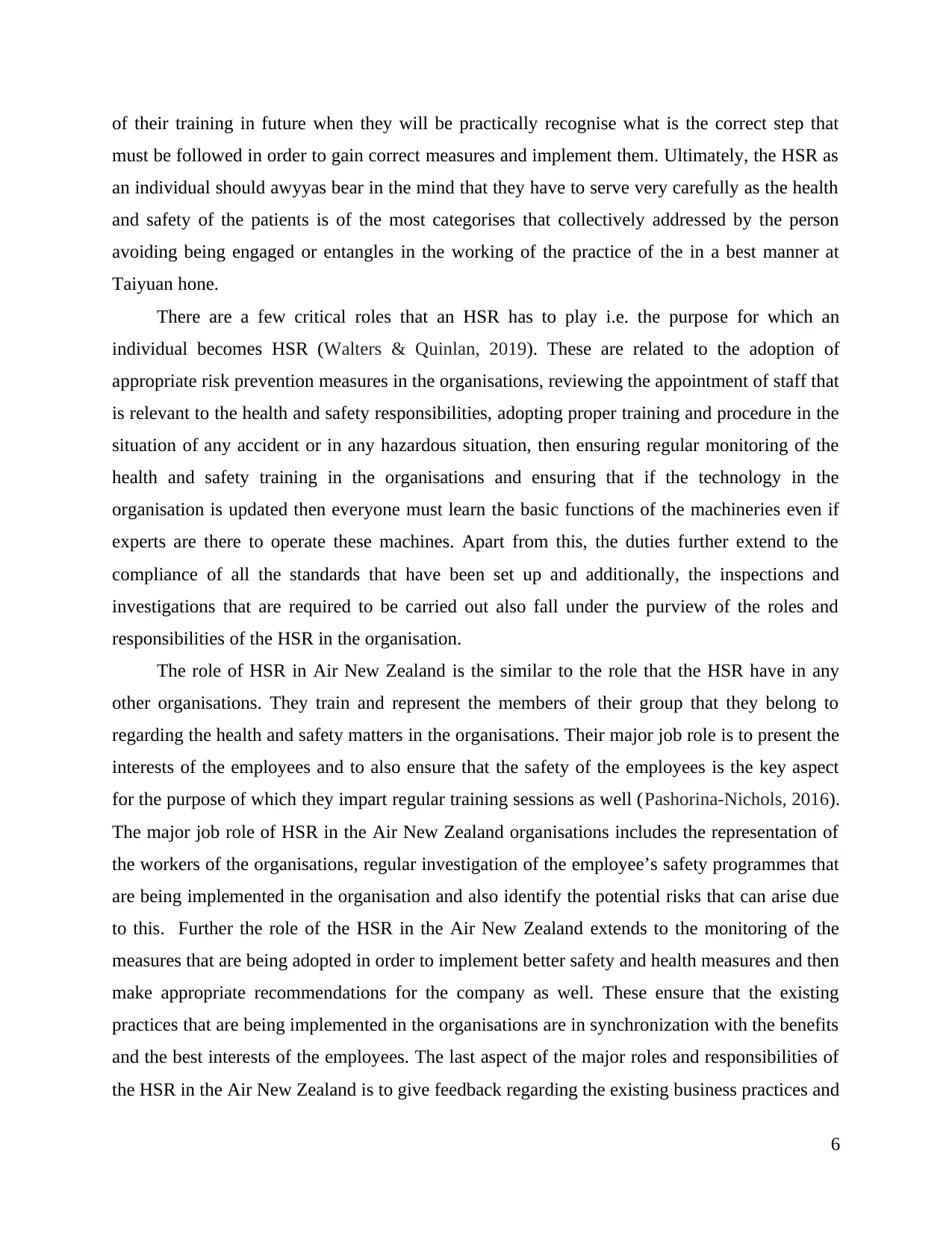
of their training in future when they will be practically recognise what is the correct step that
must be followed in order to gain correct measures and implement them. Ultimately, the HSR as
an individual should awyyas bear in the mind that they have to serve very carefully as the health
and safety of the patients is of the most categorises that collectively addressed by the person
avoiding being engaged or entangles in the working of the practice of the in a best manner at
Taiyuan hone.
There are a few critical roles that an HSR has to play i.e. the purpose for which an
individual becomes HSR (Walters & Quinlan, 2019). These are related to the adoption of
appropriate risk prevention measures in the organisations, reviewing the appointment of staff that
is relevant to the health and safety responsibilities, adopting proper training and procedure in the
situation of any accident or in any hazardous situation, then ensuring regular monitoring of the
health and safety training in the organisations and ensuring that if the technology in the
organisation is updated then everyone must learn the basic functions of the machineries even if
experts are there to operate these machines. Apart from this, the duties further extend to the
compliance of all the standards that have been set up and additionally, the inspections and
investigations that are required to be carried out also fall under the purview of the roles and
responsibilities of the HSR in the organisation.
The role of HSR in Air New Zealand is the similar to the role that the HSR have in any
other organisations. They train and represent the members of their group that they belong to
regarding the health and safety matters in the organisations. Their major job role is to present the
interests of the employees and to also ensure that the safety of the employees is the key aspect
for the purpose of which they impart regular training sessions as well (Pashorina-Nichols, 2016).
The major job role of HSR in the Air New Zealand organisations includes the representation of
the workers of the organisations, regular investigation of the employee’s safety programmes that
are being implemented in the organisation and also identify the potential risks that can arise due
to this. Further the role of the HSR in the Air New Zealand extends to the monitoring of the
measures that are being adopted in order to implement better safety and health measures and then
make appropriate recommendations for the company as well. These ensure that the existing
practices that are being implemented in the organisations are in synchronization with the benefits
and the best interests of the employees. The last aspect of the major roles and responsibilities of
the HSR in the Air New Zealand is to give feedback regarding the existing business practices and
6
must be followed in order to gain correct measures and implement them. Ultimately, the HSR as
an individual should awyyas bear in the mind that they have to serve very carefully as the health
and safety of the patients is of the most categorises that collectively addressed by the person
avoiding being engaged or entangles in the working of the practice of the in a best manner at
Taiyuan hone.
There are a few critical roles that an HSR has to play i.e. the purpose for which an
individual becomes HSR (Walters & Quinlan, 2019). These are related to the adoption of
appropriate risk prevention measures in the organisations, reviewing the appointment of staff that
is relevant to the health and safety responsibilities, adopting proper training and procedure in the
situation of any accident or in any hazardous situation, then ensuring regular monitoring of the
health and safety training in the organisations and ensuring that if the technology in the
organisation is updated then everyone must learn the basic functions of the machineries even if
experts are there to operate these machines. Apart from this, the duties further extend to the
compliance of all the standards that have been set up and additionally, the inspections and
investigations that are required to be carried out also fall under the purview of the roles and
responsibilities of the HSR in the organisation.
The role of HSR in Air New Zealand is the similar to the role that the HSR have in any
other organisations. They train and represent the members of their group that they belong to
regarding the health and safety matters in the organisations. Their major job role is to present the
interests of the employees and to also ensure that the safety of the employees is the key aspect
for the purpose of which they impart regular training sessions as well (Pashorina-Nichols, 2016).
The major job role of HSR in the Air New Zealand organisations includes the representation of
the workers of the organisations, regular investigation of the employee’s safety programmes that
are being implemented in the organisation and also identify the potential risks that can arise due
to this. Further the role of the HSR in the Air New Zealand extends to the monitoring of the
measures that are being adopted in order to implement better safety and health measures and then
make appropriate recommendations for the company as well. These ensure that the existing
practices that are being implemented in the organisations are in synchronization with the benefits
and the best interests of the employees. The last aspect of the major roles and responsibilities of
the HSR in the Air New Zealand is to give feedback regarding the existing business practices and
6
⊘ This is a preview!⊘
Do you want full access?
Subscribe today to unlock all pages.

Trusted by 1+ million students worldwide
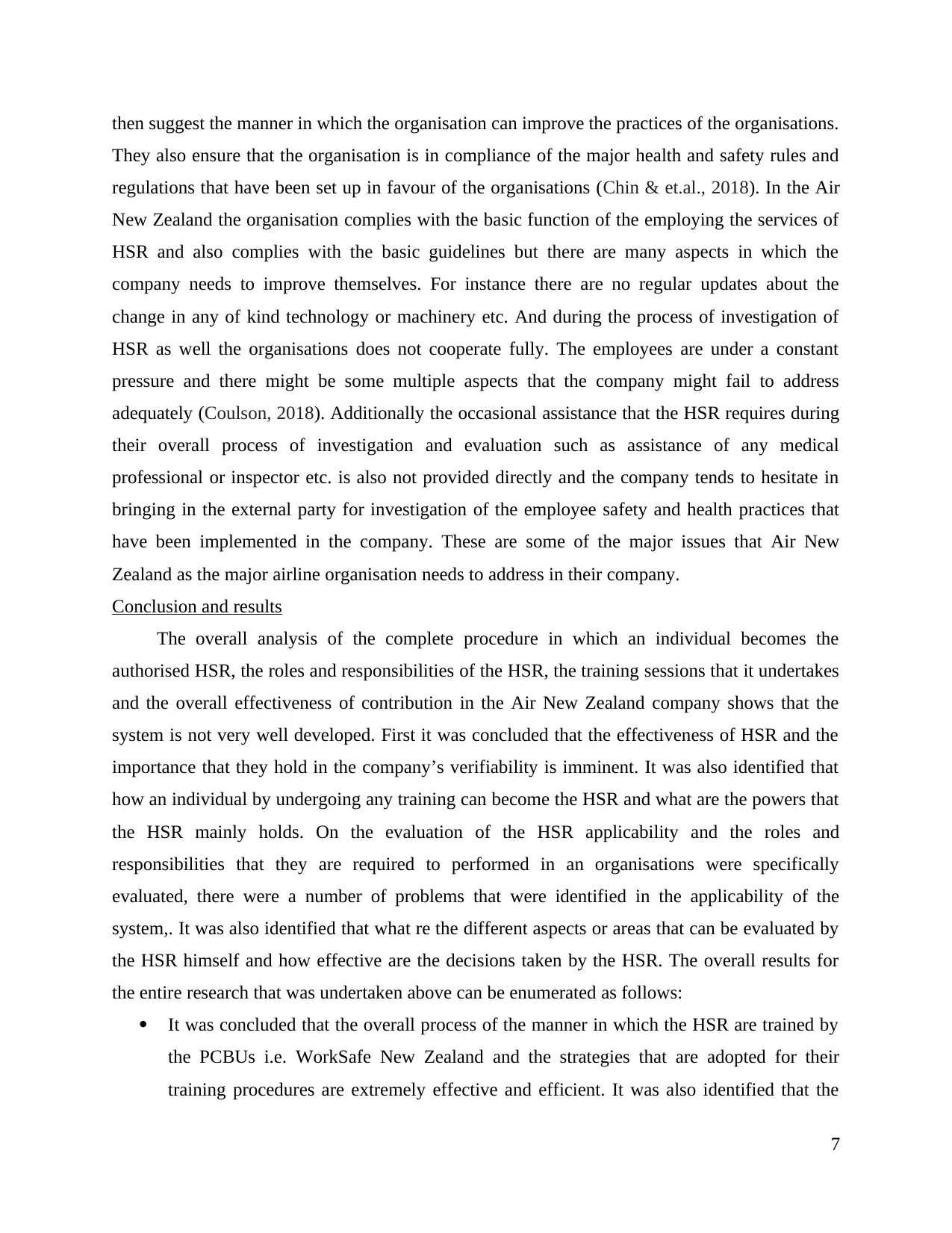
then suggest the manner in which the organisation can improve the practices of the organisations.
They also ensure that the organisation is in compliance of the major health and safety rules and
regulations that have been set up in favour of the organisations (Chin & et.al., 2018). In the Air
New Zealand the organisation complies with the basic function of the employing the services of
HSR and also complies with the basic guidelines but there are many aspects in which the
company needs to improve themselves. For instance there are no regular updates about the
change in any of kind technology or machinery etc. And during the process of investigation of
HSR as well the organisations does not cooperate fully. The employees are under a constant
pressure and there might be some multiple aspects that the company might fail to address
adequately (Coulson, 2018). Additionally the occasional assistance that the HSR requires during
their overall process of investigation and evaluation such as assistance of any medical
professional or inspector etc. is also not provided directly and the company tends to hesitate in
bringing in the external party for investigation of the employee safety and health practices that
have been implemented in the company. These are some of the major issues that Air New
Zealand as the major airline organisation needs to address in their company.
Conclusion and results
The overall analysis of the complete procedure in which an individual becomes the
authorised HSR, the roles and responsibilities of the HSR, the training sessions that it undertakes
and the overall effectiveness of contribution in the Air New Zealand company shows that the
system is not very well developed. First it was concluded that the effectiveness of HSR and the
importance that they hold in the company’s verifiability is imminent. It was also identified that
how an individual by undergoing any training can become the HSR and what are the powers that
the HSR mainly holds. On the evaluation of the HSR applicability and the roles and
responsibilities that they are required to performed in an organisations were specifically
evaluated, there were a number of problems that were identified in the applicability of the
system,. It was also identified that what re the different aspects or areas that can be evaluated by
the HSR himself and how effective are the decisions taken by the HSR. The overall results for
the entire research that was undertaken above can be enumerated as follows:
It was concluded that the overall process of the manner in which the HSR are trained by
the PCBUs i.e. WorkSafe New Zealand and the strategies that are adopted for their
training procedures are extremely effective and efficient. It was also identified that the
7
They also ensure that the organisation is in compliance of the major health and safety rules and
regulations that have been set up in favour of the organisations (Chin & et.al., 2018). In the Air
New Zealand the organisation complies with the basic function of the employing the services of
HSR and also complies with the basic guidelines but there are many aspects in which the
company needs to improve themselves. For instance there are no regular updates about the
change in any of kind technology or machinery etc. And during the process of investigation of
HSR as well the organisations does not cooperate fully. The employees are under a constant
pressure and there might be some multiple aspects that the company might fail to address
adequately (Coulson, 2018). Additionally the occasional assistance that the HSR requires during
their overall process of investigation and evaluation such as assistance of any medical
professional or inspector etc. is also not provided directly and the company tends to hesitate in
bringing in the external party for investigation of the employee safety and health practices that
have been implemented in the company. These are some of the major issues that Air New
Zealand as the major airline organisation needs to address in their company.
Conclusion and results
The overall analysis of the complete procedure in which an individual becomes the
authorised HSR, the roles and responsibilities of the HSR, the training sessions that it undertakes
and the overall effectiveness of contribution in the Air New Zealand company shows that the
system is not very well developed. First it was concluded that the effectiveness of HSR and the
importance that they hold in the company’s verifiability is imminent. It was also identified that
how an individual by undergoing any training can become the HSR and what are the powers that
the HSR mainly holds. On the evaluation of the HSR applicability and the roles and
responsibilities that they are required to performed in an organisations were specifically
evaluated, there were a number of problems that were identified in the applicability of the
system,. It was also identified that what re the different aspects or areas that can be evaluated by
the HSR himself and how effective are the decisions taken by the HSR. The overall results for
the entire research that was undertaken above can be enumerated as follows:
It was concluded that the overall process of the manner in which the HSR are trained by
the PCBUs i.e. WorkSafe New Zealand and the strategies that are adopted for their
training procedures are extremely effective and efficient. It was also identified that the
7
Paraphrase This Document
Need a fresh take? Get an instant paraphrase of this document with our AI Paraphraser
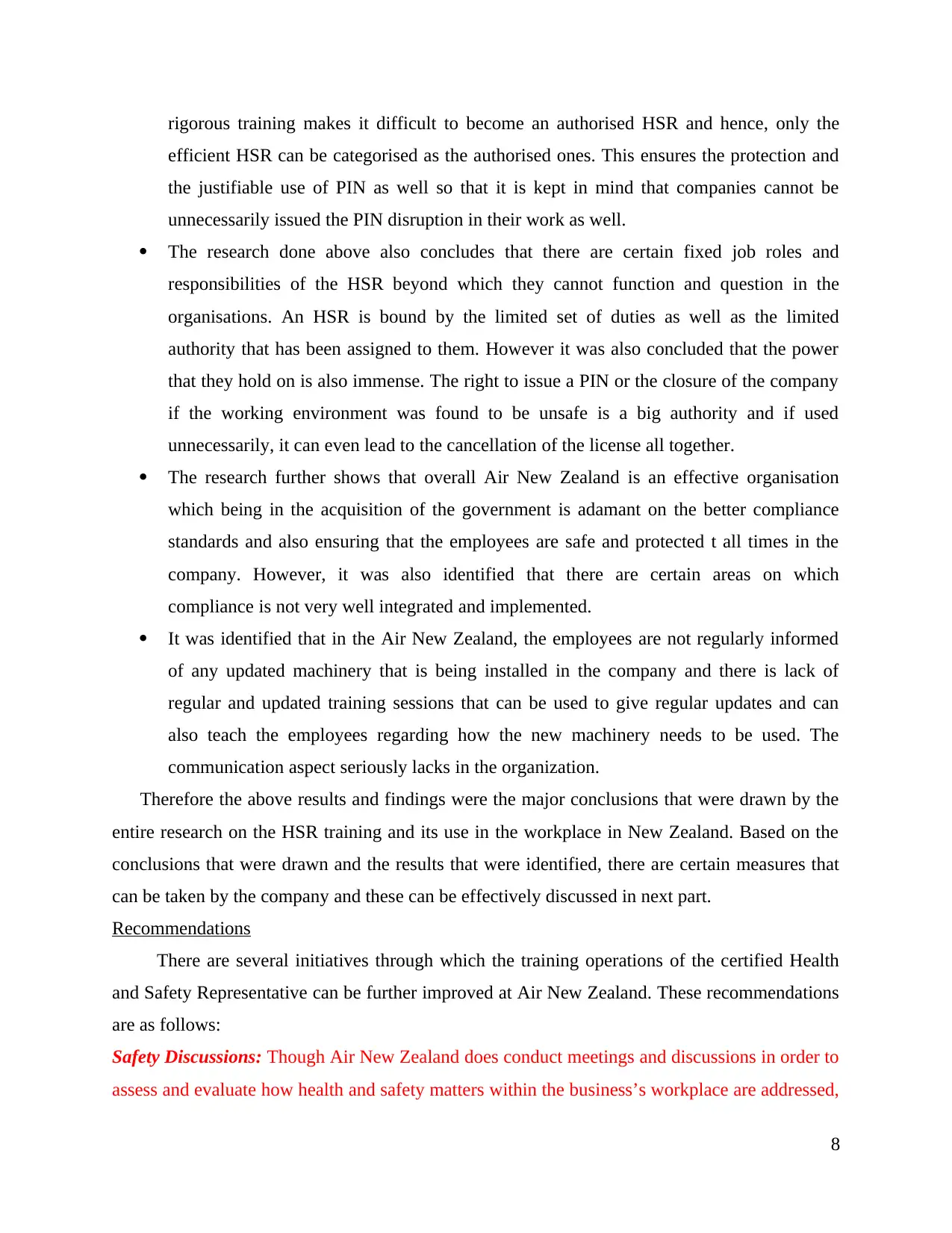
rigorous training makes it difficult to become an authorised HSR and hence, only the
efficient HSR can be categorised as the authorised ones. This ensures the protection and
the justifiable use of PIN as well so that it is kept in mind that companies cannot be
unnecessarily issued the PIN disruption in their work as well.
The research done above also concludes that there are certain fixed job roles and
responsibilities of the HSR beyond which they cannot function and question in the
organisations. An HSR is bound by the limited set of duties as well as the limited
authority that has been assigned to them. However it was also concluded that the power
that they hold on is also immense. The right to issue a PIN or the closure of the company
if the working environment was found to be unsafe is a big authority and if used
unnecessarily, it can even lead to the cancellation of the license all together.
The research further shows that overall Air New Zealand is an effective organisation
which being in the acquisition of the government is adamant on the better compliance
standards and also ensuring that the employees are safe and protected t all times in the
company. However, it was also identified that there are certain areas on which
compliance is not very well integrated and implemented.
It was identified that in the Air New Zealand, the employees are not regularly informed
of any updated machinery that is being installed in the company and there is lack of
regular and updated training sessions that can be used to give regular updates and can
also teach the employees regarding how the new machinery needs to be used. The
communication aspect seriously lacks in the organization.
Therefore the above results and findings were the major conclusions that were drawn by the
entire research on the HSR training and its use in the workplace in New Zealand. Based on the
conclusions that were drawn and the results that were identified, there are certain measures that
can be taken by the company and these can be effectively discussed in next part.
Recommendations
There are several initiatives through which the training operations of the certified Health
and Safety Representative can be further improved at Air New Zealand. These recommendations
are as follows:
Safety Discussions: Though Air New Zealand does conduct meetings and discussions in order to
assess and evaluate how health and safety matters within the business’s workplace are addressed,
8
efficient HSR can be categorised as the authorised ones. This ensures the protection and
the justifiable use of PIN as well so that it is kept in mind that companies cannot be
unnecessarily issued the PIN disruption in their work as well.
The research done above also concludes that there are certain fixed job roles and
responsibilities of the HSR beyond which they cannot function and question in the
organisations. An HSR is bound by the limited set of duties as well as the limited
authority that has been assigned to them. However it was also concluded that the power
that they hold on is also immense. The right to issue a PIN or the closure of the company
if the working environment was found to be unsafe is a big authority and if used
unnecessarily, it can even lead to the cancellation of the license all together.
The research further shows that overall Air New Zealand is an effective organisation
which being in the acquisition of the government is adamant on the better compliance
standards and also ensuring that the employees are safe and protected t all times in the
company. However, it was also identified that there are certain areas on which
compliance is not very well integrated and implemented.
It was identified that in the Air New Zealand, the employees are not regularly informed
of any updated machinery that is being installed in the company and there is lack of
regular and updated training sessions that can be used to give regular updates and can
also teach the employees regarding how the new machinery needs to be used. The
communication aspect seriously lacks in the organization.
Therefore the above results and findings were the major conclusions that were drawn by the
entire research on the HSR training and its use in the workplace in New Zealand. Based on the
conclusions that were drawn and the results that were identified, there are certain measures that
can be taken by the company and these can be effectively discussed in next part.
Recommendations
There are several initiatives through which the training operations of the certified Health
and Safety Representative can be further improved at Air New Zealand. These recommendations
are as follows:
Safety Discussions: Though Air New Zealand does conduct meetings and discussions in order to
assess and evaluate how health and safety matters within the business’s workplace are addressed,
8
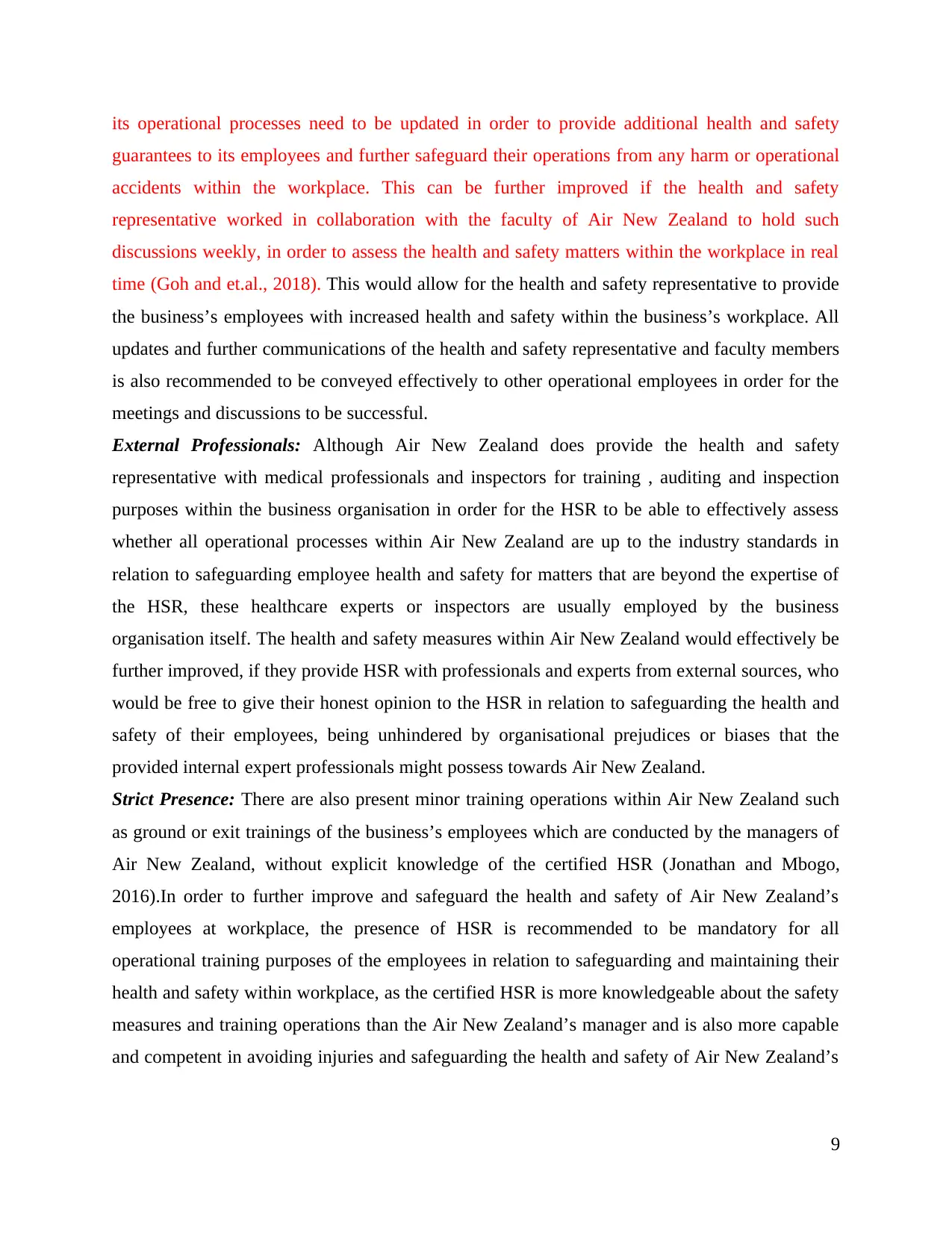
its operational processes need to be updated in order to provide additional health and safety
guarantees to its employees and further safeguard their operations from any harm or operational
accidents within the workplace. This can be further improved if the health and safety
representative worked in collaboration with the faculty of Air New Zealand to hold such
discussions weekly, in order to assess the health and safety matters within the workplace in real
time (Goh and et.al., 2018). This would allow for the health and safety representative to provide
the business’s employees with increased health and safety within the business’s workplace. All
updates and further communications of the health and safety representative and faculty members
is also recommended to be conveyed effectively to other operational employees in order for the
meetings and discussions to be successful.
External Professionals: Although Air New Zealand does provide the health and safety
representative with medical professionals and inspectors for training , auditing and inspection
purposes within the business organisation in order for the HSR to be able to effectively assess
whether all operational processes within Air New Zealand are up to the industry standards in
relation to safeguarding employee health and safety for matters that are beyond the expertise of
the HSR, these healthcare experts or inspectors are usually employed by the business
organisation itself. The health and safety measures within Air New Zealand would effectively be
further improved, if they provide HSR with professionals and experts from external sources, who
would be free to give their honest opinion to the HSR in relation to safeguarding the health and
safety of their employees, being unhindered by organisational prejudices or biases that the
provided internal expert professionals might possess towards Air New Zealand.
Strict Presence: There are also present minor training operations within Air New Zealand such
as ground or exit trainings of the business’s employees which are conducted by the managers of
Air New Zealand, without explicit knowledge of the certified HSR (Jonathan and Mbogo,
2016).In order to further improve and safeguard the health and safety of Air New Zealand’s
employees at workplace, the presence of HSR is recommended to be mandatory for all
operational training purposes of the employees in relation to safeguarding and maintaining their
health and safety within workplace, as the certified HSR is more knowledgeable about the safety
measures and training operations than the Air New Zealand’s manager and is also more capable
and competent in avoiding injuries and safeguarding the health and safety of Air New Zealand’s
9
guarantees to its employees and further safeguard their operations from any harm or operational
accidents within the workplace. This can be further improved if the health and safety
representative worked in collaboration with the faculty of Air New Zealand to hold such
discussions weekly, in order to assess the health and safety matters within the workplace in real
time (Goh and et.al., 2018). This would allow for the health and safety representative to provide
the business’s employees with increased health and safety within the business’s workplace. All
updates and further communications of the health and safety representative and faculty members
is also recommended to be conveyed effectively to other operational employees in order for the
meetings and discussions to be successful.
External Professionals: Although Air New Zealand does provide the health and safety
representative with medical professionals and inspectors for training , auditing and inspection
purposes within the business organisation in order for the HSR to be able to effectively assess
whether all operational processes within Air New Zealand are up to the industry standards in
relation to safeguarding employee health and safety for matters that are beyond the expertise of
the HSR, these healthcare experts or inspectors are usually employed by the business
organisation itself. The health and safety measures within Air New Zealand would effectively be
further improved, if they provide HSR with professionals and experts from external sources, who
would be free to give their honest opinion to the HSR in relation to safeguarding the health and
safety of their employees, being unhindered by organisational prejudices or biases that the
provided internal expert professionals might possess towards Air New Zealand.
Strict Presence: There are also present minor training operations within Air New Zealand such
as ground or exit trainings of the business’s employees which are conducted by the managers of
Air New Zealand, without explicit knowledge of the certified HSR (Jonathan and Mbogo,
2016).In order to further improve and safeguard the health and safety of Air New Zealand’s
employees at workplace, the presence of HSR is recommended to be mandatory for all
operational training purposes of the employees in relation to safeguarding and maintaining their
health and safety within workplace, as the certified HSR is more knowledgeable about the safety
measures and training operations than the Air New Zealand’s manager and is also more capable
and competent in avoiding injuries and safeguarding the health and safety of Air New Zealand’s
9
⊘ This is a preview!⊘
Do you want full access?
Subscribe today to unlock all pages.

Trusted by 1+ million students worldwide
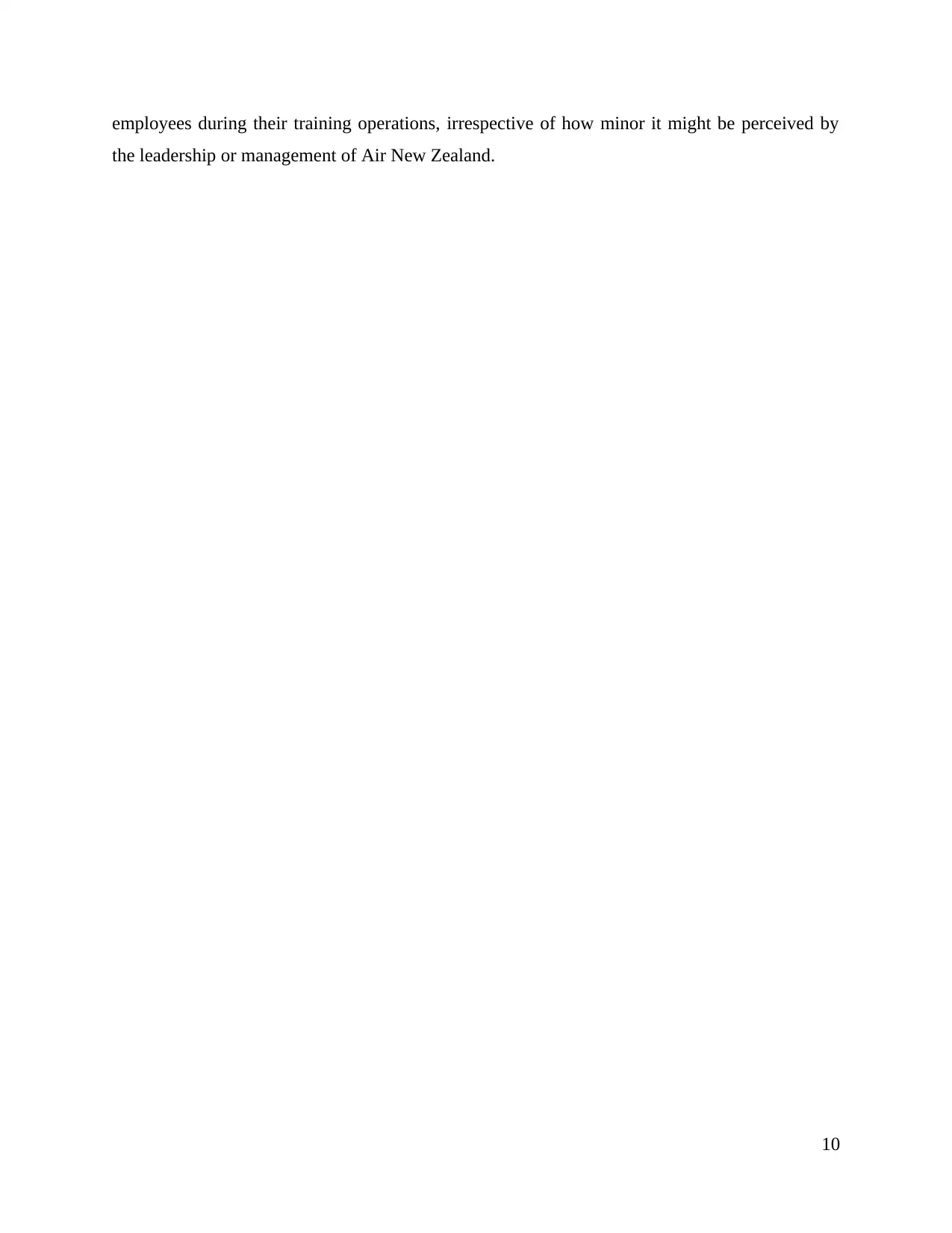
employees during their training operations, irrespective of how minor it might be perceived by
the leadership or management of Air New Zealand.
10
the leadership or management of Air New Zealand.
10
Paraphrase This Document
Need a fresh take? Get an instant paraphrase of this document with our AI Paraphraser
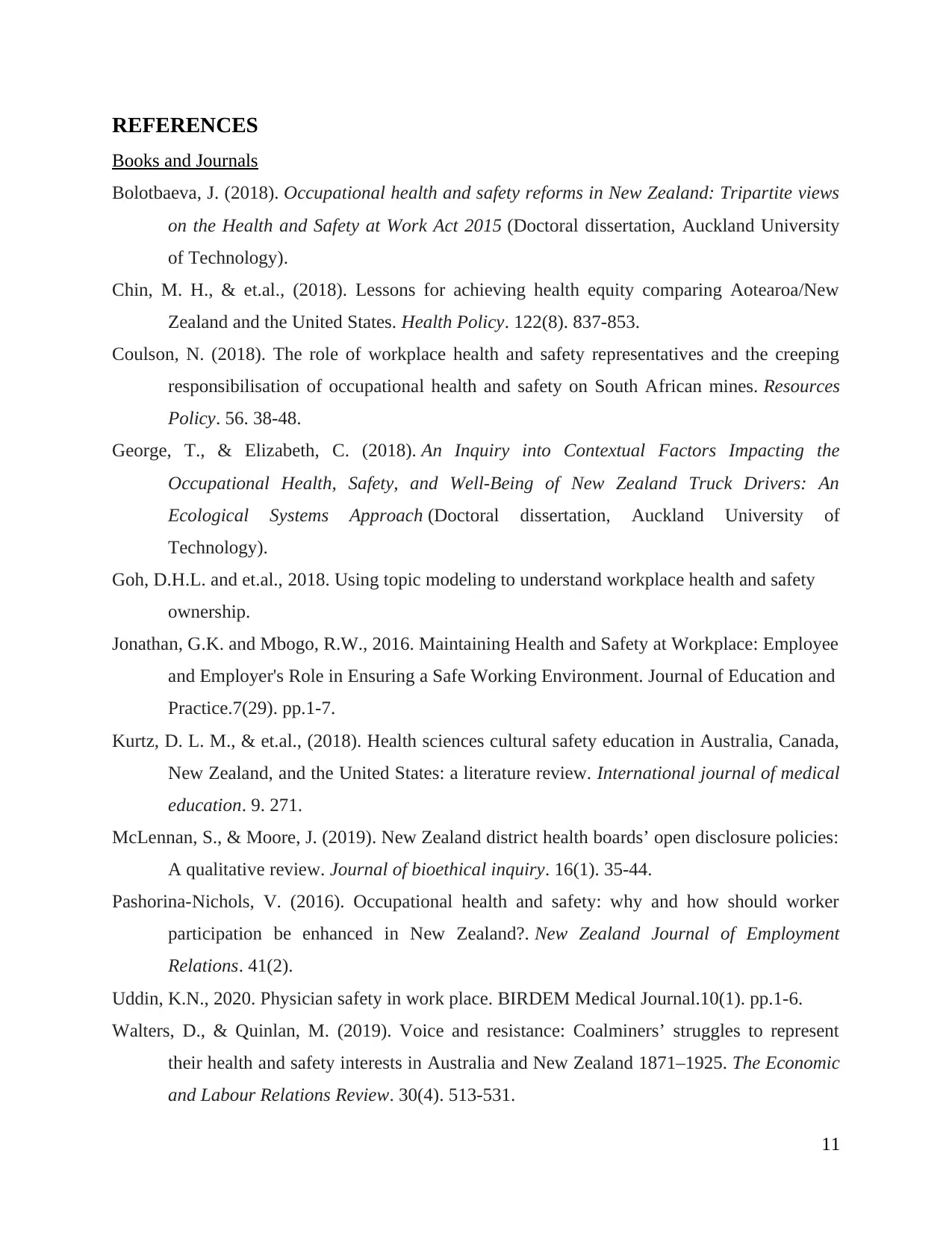
REFERENCES
Books and Journals
Bolotbaeva, J. (2018). Occupational health and safety reforms in New Zealand: Tripartite views
on the Health and Safety at Work Act 2015 (Doctoral dissertation, Auckland University
of Technology).
Chin, M. H., & et.al., (2018). Lessons for achieving health equity comparing Aotearoa/New
Zealand and the United States. Health Policy. 122(8). 837-853.
Coulson, N. (2018). The role of workplace health and safety representatives and the creeping
responsibilisation of occupational health and safety on South African mines. Resources
Policy. 56. 38-48.
George, T., & Elizabeth, C. (2018). An Inquiry into Contextual Factors Impacting the
Occupational Health, Safety, and Well-Being of New Zealand Truck Drivers: An
Ecological Systems Approach (Doctoral dissertation, Auckland University of
Technology).
Goh, D.H.L. and et.al., 2018. Using topic modeling to understand workplace health and safety
ownership.
Jonathan, G.K. and Mbogo, R.W., 2016. Maintaining Health and Safety at Workplace: Employee
and Employer's Role in Ensuring a Safe Working Environment. Journal of Education and
Practice.7(29). pp.1-7.
Kurtz, D. L. M., & et.al., (2018). Health sciences cultural safety education in Australia, Canada,
New Zealand, and the United States: a literature review. International journal of medical
education. 9. 271.
McLennan, S., & Moore, J. (2019). New Zealand district health boards’ open disclosure policies:
A qualitative review. Journal of bioethical inquiry. 16(1). 35-44.
Pashorina-Nichols, V. (2016). Occupational health and safety: why and how should worker
participation be enhanced in New Zealand?. New Zealand Journal of Employment
Relations. 41(2).
Uddin, K.N., 2020. Physician safety in work place. BIRDEM Medical Journal.10(1). pp.1-6.
Walters, D., & Quinlan, M. (2019). Voice and resistance: Coalminers’ struggles to represent
their health and safety interests in Australia and New Zealand 1871–1925. The Economic
and Labour Relations Review. 30(4). 513-531.
11
Books and Journals
Bolotbaeva, J. (2018). Occupational health and safety reforms in New Zealand: Tripartite views
on the Health and Safety at Work Act 2015 (Doctoral dissertation, Auckland University
of Technology).
Chin, M. H., & et.al., (2018). Lessons for achieving health equity comparing Aotearoa/New
Zealand and the United States. Health Policy. 122(8). 837-853.
Coulson, N. (2018). The role of workplace health and safety representatives and the creeping
responsibilisation of occupational health and safety on South African mines. Resources
Policy. 56. 38-48.
George, T., & Elizabeth, C. (2018). An Inquiry into Contextual Factors Impacting the
Occupational Health, Safety, and Well-Being of New Zealand Truck Drivers: An
Ecological Systems Approach (Doctoral dissertation, Auckland University of
Technology).
Goh, D.H.L. and et.al., 2018. Using topic modeling to understand workplace health and safety
ownership.
Jonathan, G.K. and Mbogo, R.W., 2016. Maintaining Health and Safety at Workplace: Employee
and Employer's Role in Ensuring a Safe Working Environment. Journal of Education and
Practice.7(29). pp.1-7.
Kurtz, D. L. M., & et.al., (2018). Health sciences cultural safety education in Australia, Canada,
New Zealand, and the United States: a literature review. International journal of medical
education. 9. 271.
McLennan, S., & Moore, J. (2019). New Zealand district health boards’ open disclosure policies:
A qualitative review. Journal of bioethical inquiry. 16(1). 35-44.
Pashorina-Nichols, V. (2016). Occupational health and safety: why and how should worker
participation be enhanced in New Zealand?. New Zealand Journal of Employment
Relations. 41(2).
Uddin, K.N., 2020. Physician safety in work place. BIRDEM Medical Journal.10(1). pp.1-6.
Walters, D., & Quinlan, M. (2019). Voice and resistance: Coalminers’ struggles to represent
their health and safety interests in Australia and New Zealand 1871–1925. The Economic
and Labour Relations Review. 30(4). 513-531.
11
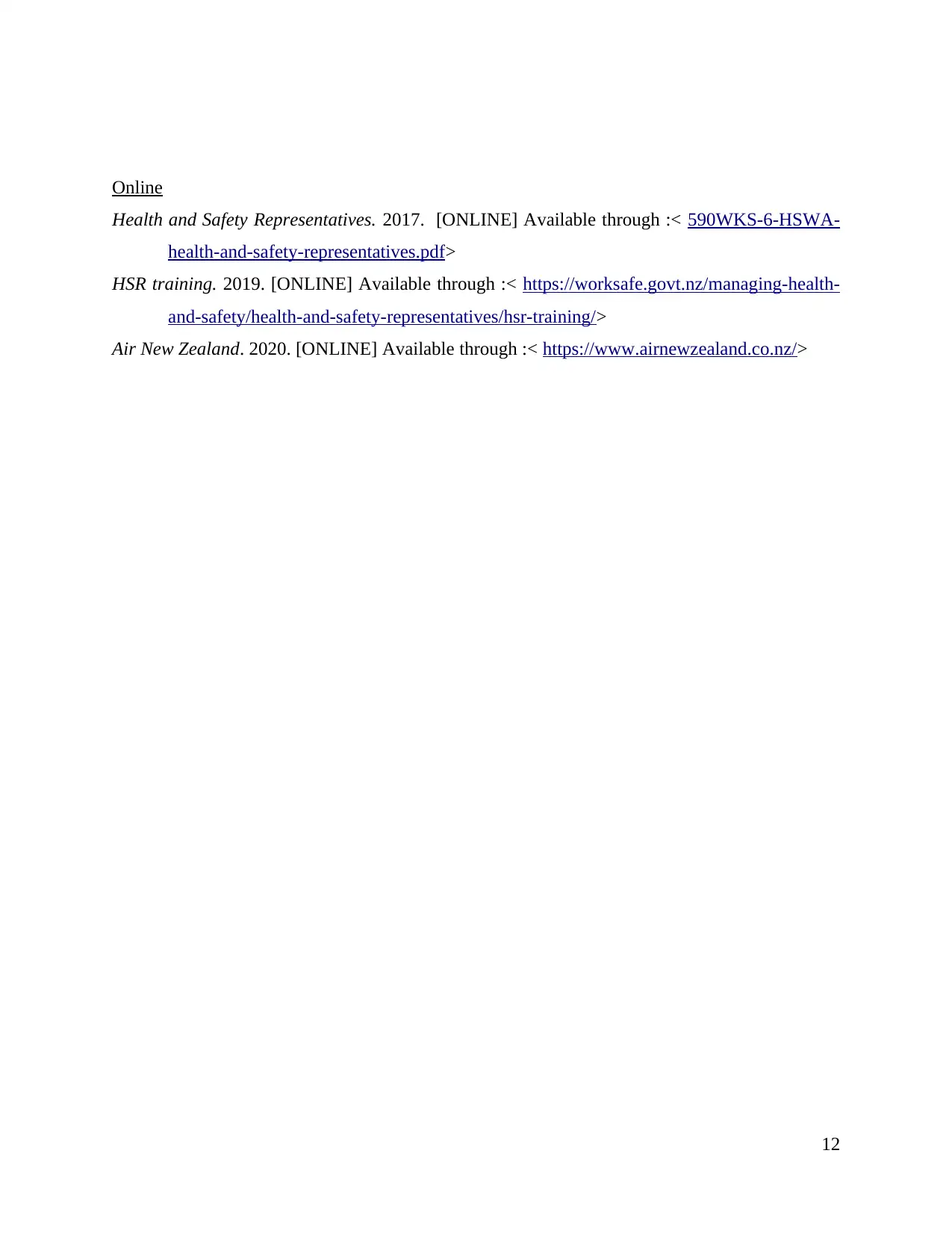
Online
Health and Safety Representatives. 2017. [ONLINE] Available through :< 590WKS-6-HSWA-
health-and-safety-representatives.pdf>
HSR training. 2019. [ONLINE] Available through :< https://worksafe.govt.nz/managing-health-
and-safety/health-and-safety-representatives/hsr-training/>
Air New Zealand. 2020. [ONLINE] Available through :< https://www.airnewzealand.co.nz/>
12
Health and Safety Representatives. 2017. [ONLINE] Available through :< 590WKS-6-HSWA-
health-and-safety-representatives.pdf>
HSR training. 2019. [ONLINE] Available through :< https://worksafe.govt.nz/managing-health-
and-safety/health-and-safety-representatives/hsr-training/>
Air New Zealand. 2020. [ONLINE] Available through :< https://www.airnewzealand.co.nz/>
12
⊘ This is a preview!⊘
Do you want full access?
Subscribe today to unlock all pages.

Trusted by 1+ million students worldwide
1 out of 13
Related Documents
Your All-in-One AI-Powered Toolkit for Academic Success.
+13062052269
info@desklib.com
Available 24*7 on WhatsApp / Email
![[object Object]](/_next/static/media/star-bottom.7253800d.svg)
Unlock your academic potential
Copyright © 2020–2025 A2Z Services. All Rights Reserved. Developed and managed by ZUCOL.





